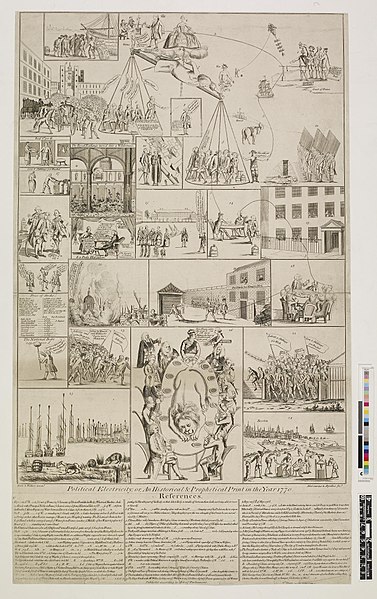File:Political electricity; or, an historical & prophetical print in the year 1770. (BM 1868,0808.4445).jpg

Original file (1,574 × 2,500 pixels, file size: 913 KB, MIME type: image/jpeg)
Captions
Captions
Summary[edit]
| Political electricity; or, an historical & prophetical print in the year 1770.
( |
||||||||||||||||||||||||
|---|---|---|---|---|---|---|---|---|---|---|---|---|---|---|---|---|---|---|---|---|---|---|---|---|
| Title |
Political electricity; or, an historical & prophetical print in the year 1770. |
|||||||||||||||||||||||
| Description |
English: Satire attacking the Duke of Grafton's government shortly before his resignation on 30 January 1770; a sheet composed of different scenes and compartments numbered from 1 to 26 in relation to a key below.
Etching |
|||||||||||||||||||||||
| Depicted people | Associated with: Benjamin Franklin | |||||||||||||||||||||||
| Date | 1770 (Presumably lpublished shortly after the letter to Wilkes of 8 January 1770, but before Graton's resignation on 30 January.) | |||||||||||||||||||||||
| Medium | paper | |||||||||||||||||||||||
| Dimensions |
|
|||||||||||||||||||||||
| Collection |
institution QS:P195,Q6373 |
|||||||||||||||||||||||
| Current location |
Prints and Drawings |
|||||||||||||||||||||||
| Accession number |
1868,0808.4445 |
|||||||||||||||||||||||
| Notes | It is now thought that the writer of anti-government letters to the press signed "Junius" was Sir Philip Francis (1740-1818). | |||||||||||||||||||||||
| Source/Photographer | https://www.britishmuseum.org/collection/object/P_1868-0808-4445 | |||||||||||||||||||||||
| Permission (Reusing this file) |
© The Trustees of the British Museum, released as CC BY-NC-SA 4.0 | |||||||||||||||||||||||
Licensing[edit]
This image is in the public domain because it is a mere mechanical scan or photocopy of a public domain original, or – from the available evidence – is so similar to such a scan or photocopy that no copyright protection can be expected to arise. The original itself is in the public domain for the following reason:
This tag is designed for use where there may be a need to assert that any enhancements (eg brightness, contrast, colour-matching, sharpening) are in themselves insufficiently creative to generate a new copyright. It can be used where it is unknown whether any enhancements have been made, as well as when the enhancements are clear but insufficient. For known raw unenhanced scans you can use an appropriate {{PD-old}} tag instead. For usage, see Commons:When to use the PD-scan tag. | |||||
File history
Click on a date/time to view the file as it appeared at that time.
| Date/Time | Thumbnail | Dimensions | User | Comment | |
|---|---|---|---|---|---|
| current | 04:10, 16 May 2020 |  | 1,574 × 2,500 (913 KB) | Copyfraud (talk | contribs) | British Museum public domain uploads (Copyfraud/BM) Satirical prints in the British Museum 1770 #11,961/12,043 |
You cannot overwrite this file.
File usage on Commons
The following page uses this file:
Metadata
This file contains additional information such as Exif metadata which may have been added by the digital camera, scanner, or software program used to create or digitize it. If the file has been modified from its original state, some details such as the timestamp may not fully reflect those of the original file. The timestamp is only as accurate as the clock in the camera, and it may be completely wrong.
| Camera manufacturer | Phase One |
|---|---|
| Camera model | P 45 |
| Date and time of data generation | 15:46, 13 December 2007 |
| ISO speed rating | 50 |
| Width | 4,300 px |
| Height | 6,830 px |
| Bits per component |
|
| Compression scheme | Uncompressed |
| Pixel composition | RGB |
| Number of components | 3 |
| Horizontal resolution | 300 dpi |
| Vertical resolution | 300 dpi |
| Exif version | 0.48 |
| Image width | 4,300 px |
| Image height | 6,830 px |
| Date and time of digitizing | 15:46, 13 December 2007 |
| File change date and time | 15:51, 13 December 2007 |
| Software used | Adobe Photoshop CS2 Macintosh |
| Date metadata was last modified | 15:51, 13 December 2007 |
- Satirical prints in the British Museum
- 1770 cartoons
- 18th-century caricatures
- American Revolution in 1770
- 1770s political cartoons
- 1770 in Great Britain
- Benjamin Franklin in art
- John Stuart, 3rd Earl of Bute
- 1769 in London
- Caricatures of people of the United Kingdom
- Brentford, London Borough of Hounslow
- Seven Years' War
- London in art
- 1770 in Boston
- Stamp Act
- British Lion
- Elections in 1768
- American Revolution cartoons
- Politics of the American Revolution
- 1769-02-03

